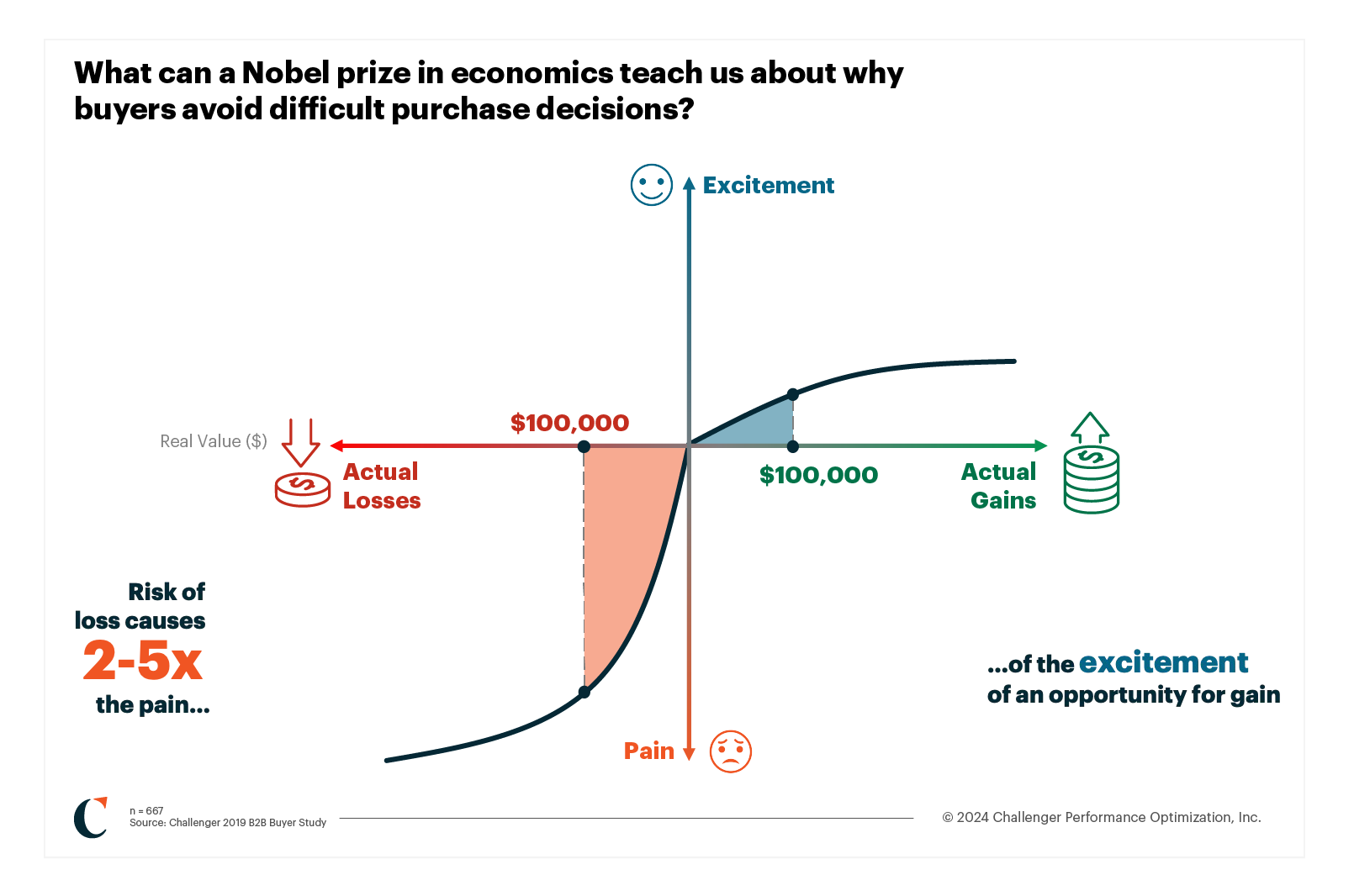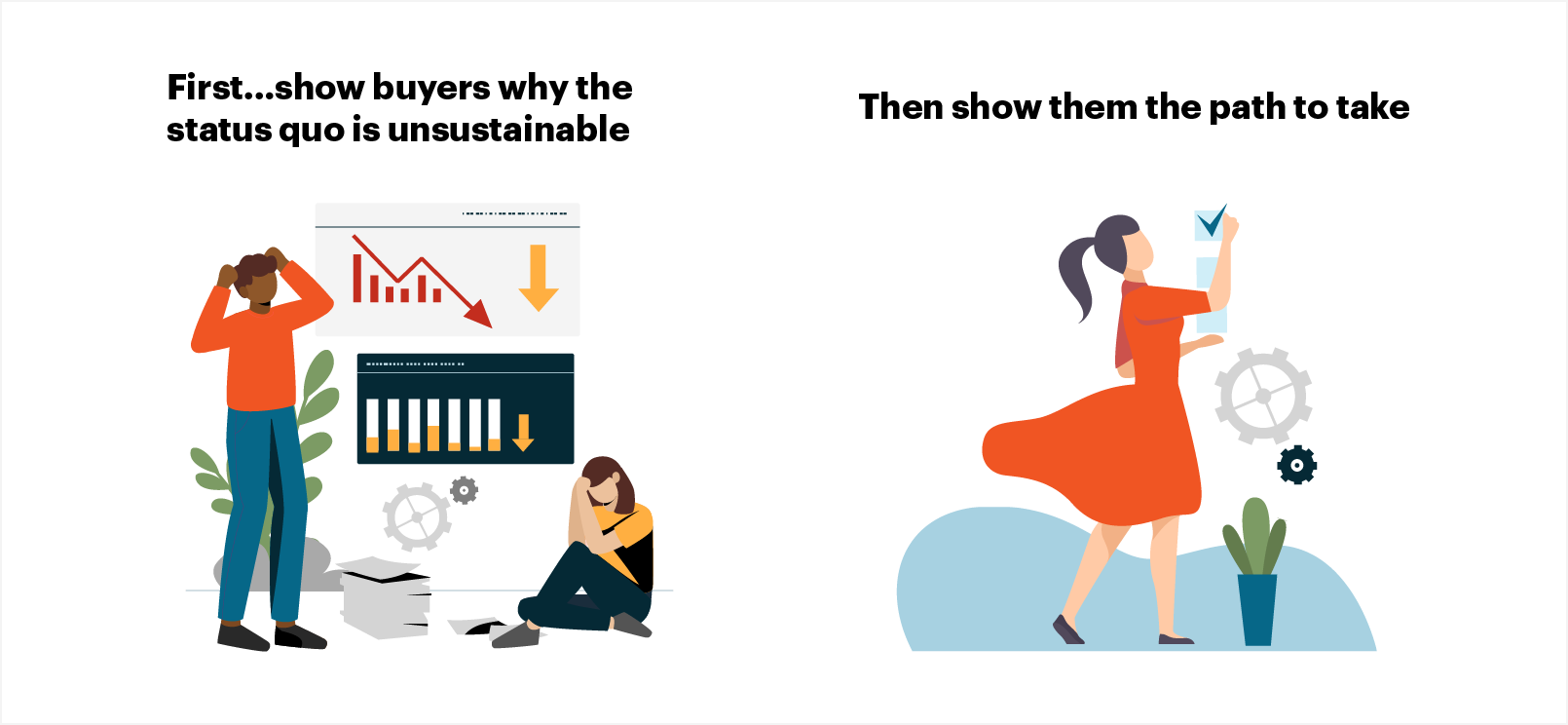Buyers don’t fail to act because they’re indecisive or uninformed — they fail to act because they’re human.
Understanding why buyers don’t change their behavior helps sales teams design messages that break through inertia, challenge assumptions, and drive commercial results.
The Psychology Behind Buyer Inertia
Behavioral economics explains that people fear loss more than they value gain — a principle known as loss aversion from Prospect Theory.
In B2B sales, that fear drives status quo bias: the tendency for decision-makers to stick with what they know, even if a better solution exists.
In short, buyers perceive the pain of potential loss (switching costs, risk, disruption) as greater than the pleasure of potential improvement.
This explains why so many deals end in no decision.
Even when your solution is superior, the buyer’s brain says, “Better safe than sorry.”

Applying Behavioral Economics to Sales Conversations
To move deals forward, top sellers learn to apply behavioral economics to sales conversations — reframing risk and reward using the science of human decision-making.
The Challenger approach uses five deliberate steps:
- Warm and Reframe — Start with empathy and redefine the buyer’s current reality.
- Rational Drowning — Quantify the cost of inaction with data that makes the status quo look unsafe.
- Emotional Impact — Tell a story that hits home. Logic informs, but emotion moves.
- New Way — Offer a credible alternative that resolves the tension you’ve created.
- Your Solution — Only now introduce how your offering uniquely reduces the buyer’s risk.
Pro Tip: Instead of focusing on potential gains, emphasize the hidden costs of staying the same. That’s how loss aversion becomes a sales strategy.
This framework transforms theory into practice, helping sellers use behavioral economics in B2B sales to motivate real change.
Questions Sellers Should Ask to Challenge Buyers
Great sellers don’t just pitch; they teach. They use strategic, insight-driven questions to challenge buyers and expose the risks of maintaining the status quo.
Here are examples of sales questions to ask buyers that create productive tension:
- “What happens if nothing changes in the next six months?”
- “Where do you see the biggest risk in doing things the current way?”
- “What would it take for your team to feel confident making a change?”
- “Which metric would worsen first if your current approach fails?”
- “What is the cost — in time or revenue — of not acting now?”
Each question reframes the conversation from features and benefits to risk, opportunity, and consequence — the terrain where decisions truly happen.
Why Buyers Stick with Doing Nothing
Many B2B buyers choose inaction not because they disagree with you, but because they can’t rationalize the emotional cost of change.
This is the status quo bias in B2B buying—an unconscious comfort with familiarity.
Sellers often try to “add value” by proving ROI, but the real lever is showing that inaction is riskier than transformation.
That’s why the Challenger approach focuses on commercial insight — teaching the buyer something new about their business that reframes their perception of safety and risk.
“Do nothing” wins by default. Great sellers make “do nothing” look dangerous.

A Loss Aversion Sales Strategy in Action
Consider a fitness coach who tells a client, “Keep lifting that way, and you’ll injure your back within a month.”
She’s not selling a new routine—she’s creating urgency by exposing a hidden risk. That’s loss aversion in its purest form.
In sales, the same psychology applies. Buyers act when they realize their current approach could cost them more than switching ever would.
Framing conversations this way turns loss aversion into a sales strategy that drives change.
Sales Leader Checklist: Using Prospect Theory in Your GTM Strategy
To embed these ideas into your enablement and sales process:
- Audit your messaging — replace gain-only claims with risk-of-inaction framing.
- Train reps to diagnose status quo bias in customer conversations.
- Role-play challenger-style discovery questions to build confidence.
- Reinforce behavioral principles in coaching sessions and call reviews.
- Track outcomes such as fewer “no decisions” and shorter sales cycles.
When teams apply behavioral economics to sales, they make buyers feel that change is the safer choice.
Key Takeaways
- Buyers resist change because of loss aversion, not lack of logic.
- Prospect Theory explains how to use perceived risk to motivate action.
- The best sellers ask insight-driven, challenging questions.
- Status quo bias is your real competitor—not another vendor.
- Applying behavioral economics in B2B sales helps you teach, not pitch.
FAQs
It’s the behavioural-economics model showing that buyers fear loss more than they value gain — critical insight for reframing sales conversations.
Because of status quo bias—the tendency to avoid risk by clinging to what feels familiar, even when better options exist.
Highlight the risks of inaction, tell emotionally resonant stories, and connect your solution as the least-risky path forward.
Ask what happens if nothing changes, what risks are being ignored, and what outcomes are at stake—not just what features they want.
Challenger supports organizations in refining their go-to-market strategy by helping them build the right message for the right stakeholders at the right time.
Learn more about our methodology and how we help organizations turn sellers into Challengers.
Veronica Coli
Veronica is Challenger's Sr. Director of Client Success. She is based in London and loves leading tailored implementation journeys with our most strategic accounts, seeing customer results, and sharing learnings across cultures and regions.
More from our blog
3 Challenger Skills That Boost Sales Rep Productivity and Motivate Buyers
Sales leaders everywhere are looking for ways to improve sales rep productivity. But productivity isn’t just about efficiency—it’s about…
Sending Commercial Teaching Messages That Inspire Action—Not Anxiety
How to Build Tension in Your Commercial Teaching Message In B2B sales, the most powerful messages aren’t horror stories, they’re dramas with a clear…
The Next Era of Challenger Selling: Skills That Will Shape the Future of Sales
In 2020, selling changed overnight. Buyers went quiet, priorities flipped, and digital interactions replaced boardroom handshakes. Everyone talked…
What are you waiting for?
Transform your sales team.
The best companies grow, and grow fast, by challenging customers, not by serving them.




